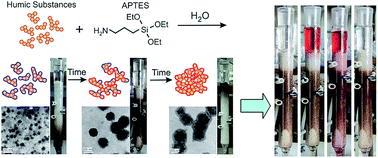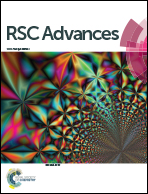Targeted design of water-based humic substances-silsesquioxane soft materials for nature-inspired remedial applications†
Abstract
Water-based humic substances-silsesquioxane (HS-SQ) soft materials are synthesized by hydrolysis of (3-aminopropyl-triethoxy)-silane in the HS solution. The aggregation dynamics of this system was studied using in situ small-angle X-ray scattering (SAXS) technique, which revealed three consecutive stages in the evolution of the HS-SQ system based on its fractal dimension (D): HS-SQ oligomeric polyelectrolyte complexes with D < 2.5; loosely bound HS-SQ networks with 2.5 < D < 3.0, and densely cross-linked networks with D > 3 (surface fractals). It was suggested that the reaction time needed for the HS-SQ system to transit from mass to surface fractal stage can be used to control its self-assembly onto a solid support. The corresponding studies have confirmed that the HS-SQ networks could be successfully immobilized onto sand columns only at the aggregation stage with fractal dimensions of 2.5 < Dm < 3. This enabled the targeted design of HS-SQ systems capable of guided self-assembly onto the solid support. The corresponding lab column studies have demonstrated successful passive installation of a humic permeable reactive barrier on sand which was capable of intercepting azo dyes from contaminated water. The prospects of using HS-SQ soft materials in nature-inspired remedial technologies and soil restoration are discussed.



 Please wait while we load your content...
Please wait while we load your content...